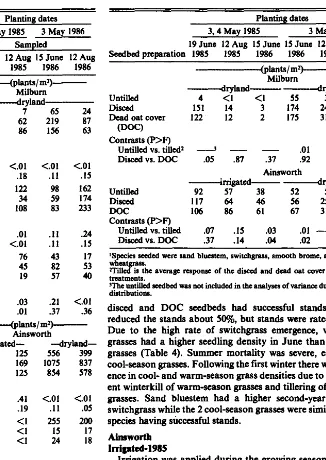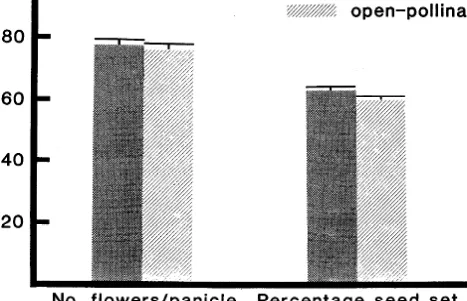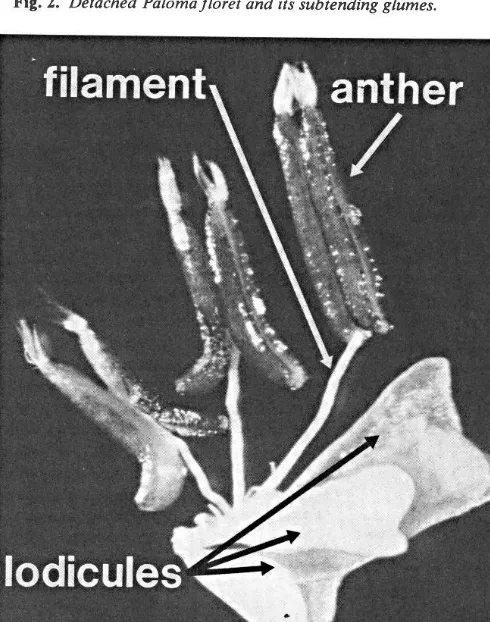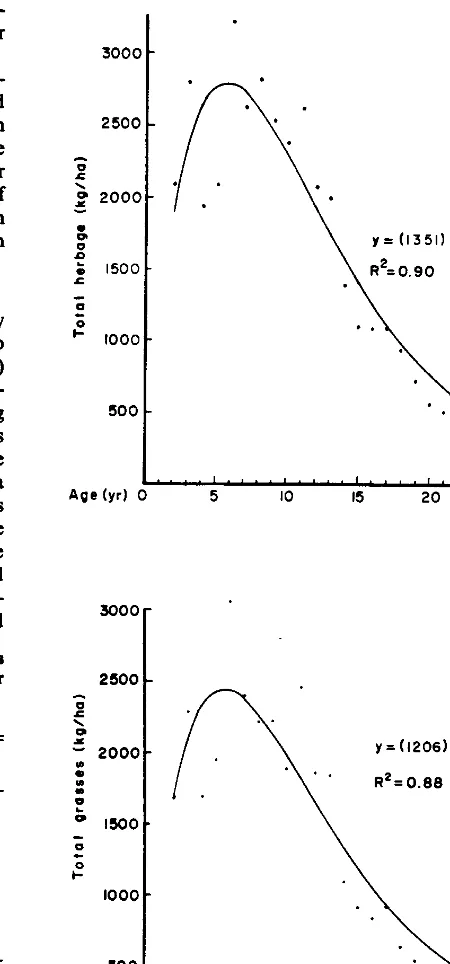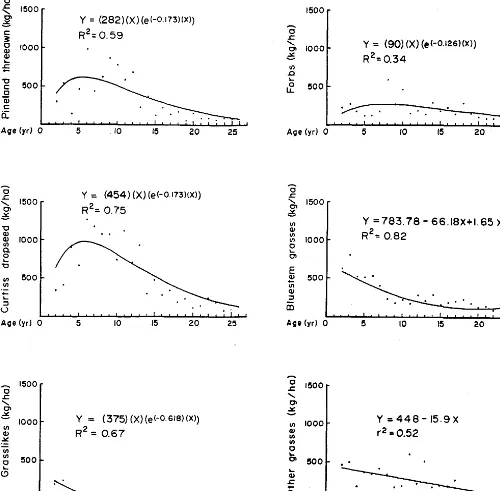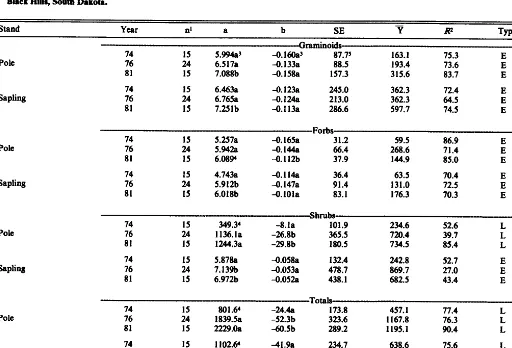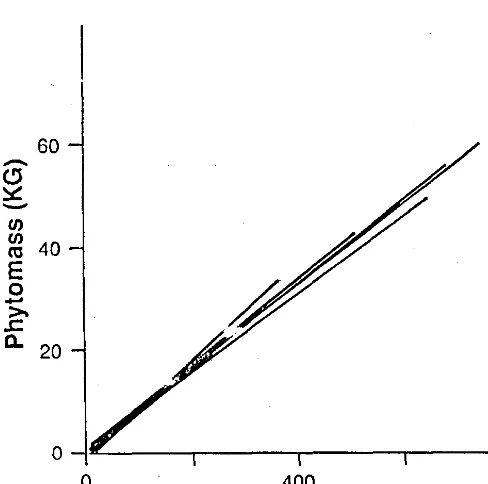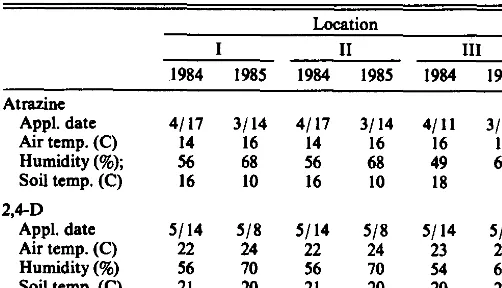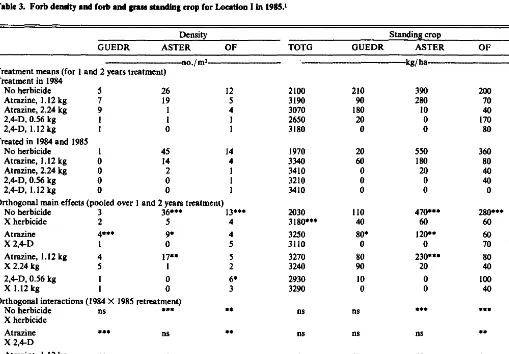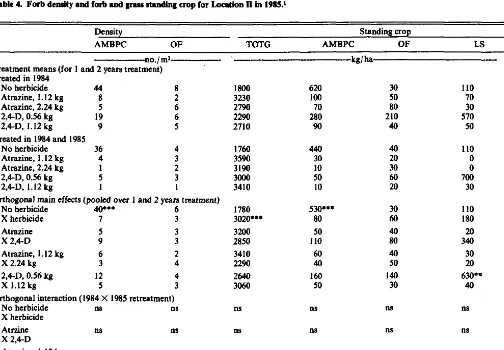TABLE OF CONTENTS:
Vol. 42, No. 3, May 1989
ARTICLES
Plant Ecology
178
183
187
191
196
199
203
209
213
Seedbed ecology of winterfat: cations in dirspore bracts and their effect on
germination and early plant growth
by D. Terrance Booth
Seedbed effects on grass establishment on abandoned Nebraska Sandhills
cropland
by Milton A. King, Steven S. Waller, Lowell E. Moser, and
James L. Stubbendieck
Self-compatibility in ‘Paloma’ Indian ricegrass
by T.A. Jones and D.C.
Nielson
Herbage yield response to the maturation of a slash pine plantation
by
Clifford E. Lewis
Accumulation of nitrate by annual goldeneye and showy goldeneye by M.
Coburn Williams
Relationship among grazing management, growing degreodays, and
morphological development for native grasses on the Northern Great
Plains
by A.B. Frank and L. Hofmann
Understory-overstory relationships in ponderosa pine forests, Black Hills,
South Dakota
by Daniel W. Uresk and Kieth E. Severson
Evaluation of pinyon sapwood to phytomass relationships over different
site conditions by Robin J. Tausch and Paul T. Tueller
Influence of mycorrhizal fungi and fertilization on big bluestem seedling
biomass
by B.A.D. Hetrick, G.W.T. Wilson, and C.E. Owensby
Improvements
217
222
Effects of 2,4-D and atrazine on degraded Oklahoma grasslands by
C.K.
Rice and J.F. Stritzke
Effects of nitrogen fertilization on spotted knapweed and competing
vegetation in western Montana
by Jim M. Story, Keith W. Boggs, and
Donald R. Graham
General Interest
225 A versatile data logging program in BASIC for the Laptop computer
by
Paul S. Graff and Billy W. Hipp
Animal Ecology
228
233
Published bimonthly-January, March, May, July, September, November Copyright 1989 by thesocietyfor Range Management
INDIVIDUAL SUBSCRIPTION is by membership in the Society for Range Management.
LIBRARY or other INSTITUTIONAL SUBSCRIP- ..-._.l.. -- _ __I__~__..___ L__.- ___ I_.. ^^ .- I w1y3 on a
carenoar year oases are *oo.uu ror ihe United States postpaid and $66.00 for other coun- tries, postpaid. Payment from outside the United States should be remitted in US dollars by interna- tional money order or draft on a New York bank. BUSINESS CORRESPONDENCE, concerning sub- scriptions, advertising, reprints, back issues, and related matters, should be addressed to the Manag- ing Editor, 1839 York Street, Denver, Colorado 80206.
EDITORIALCORRESPONDENCE, concerning manu- scriptsorothereditorial matters, should be addressed to the Editor, 1839 York Street, Denver, Colorado 80206.
INSTRUCTIONS FOR AUTHORS appear on the inside back cover of most issues. A Style Manual is also available from the Society for Range Manage- ment at theaboveaddress@$2,M)forsinglecopies; $1.25 each for 2 or more.
THE JOURNAL OF RANGE MANAGEMENT (ISSN 0022~4OQX) is published six times yearly for $56.00 per year by the Society for Range Management, 1839 York Street, Denver, Colorado 80206. SECOND CLASS POSTAGE paid at Denver, Colorado. POSTMASTER: Rotum mtlre Journal with address change-RETURN POSTAGE GUARANTEED-to Society for Range Management, 1839 York Street, Denver, Colorado 80206.
Grazing Management
239
Quality and
botanical composition of cattle
diets under
rotational and
collflnuous
grazing treatments
by John W. Walker, Rodney K. Heit-
Schmidt, Elino A. De Moraes, Merwyn M. Kothmann, and Steve L.
Dowhower
243
248
252
Beef production
from native and
seeded Northern Great Plains
ranges by
_ ___ __Don C. Adams, Robert B. Staigmiiier, and Bradford
W.Knapp
Animal performance and plant production from continuously grazed
cool-season reclaimed and
native pastures by L. Hofmann and R.E. Ries
Vegetation and soil responses to short-duration
grazing on fescue grass-
Iands by Johan F. Dormaar, Sylvester Smoliak, and Walter D. Willms
TECHNICAL NOTE
257 Evaluating
revegetation practices for sandy cropland in the Nebraska
sandhills
by S. Oldfather, J. Stubbendieclc, and S.S. Waller
BOOK REVIEWS
260
Ecological Systems of the Geobiosphere. 2. nopica
and Subtropical
Zonobiomes
by H. Walter and S.W. Breckle;
Planning for Drought
Toward a Reduction of Society Vulnerability
edited by Donald A. Wilhite
and William E. Easterling with Deborah A. Wood;
Introduction zo Plant
Production Ecology, Second Edition
by Jonathan Silverton;
Making Soil
and Water Conservation Work: Scientific and Policy Perspectives
edited
by D. W. Halbach, C.F. Runge, and W.E. Larson.
ManagIng Edltor PETER V. JACKSON Ill
1839 York Street Denver, Colorado 80206 Edltor
PATRICIA 0. SMITH
Society for Range Management 1839 York Street
Denver, Colorado 802rl6 (303) 3557070
Book Review Edltor GRANT A. HARRIS
Forestry and Range Management Washington State University Pullman, Washington QQ164-6410
ASSOCIATE EDITORS DON C. ADAMS
USDA ARS
Livestock 8 Range Research *+, Pnr?
II. I. Y”,.Y
Miles City, Montana 59301 WILL BLACKBURN
N.W. Watershed Res. Center 270 South Orchard Boise, Idaho 83705 CARLTON BRITTON
Range 8 Wildlife Mgmt Texas Tech University Lubbock, Texas 79409 TIMOTHY E. FULBRIGHT
College of Agriculture Texas A&l
POB 156, Sta. 1 Kingsviiie, Texas 78363
RICHARD H. HART BRUCE ROUNDY USDA-ARS 325 Biological Sciences 8408 Hildreth Rd. East Building, Univ. Arizona Pks.rsnna W.mminn *-a T,,rs.-... A&r,.“., OL-?b, “‘“=.,““l, ..,““““Q V&W_ I”~~“II,~llL”ll~o.J,LI RODNEY HEITSCHMIDT
Box 1658
Vernon, Texas 76384 PETE W. JACOBY, JR.
P.O. Box 1658 Vernon, Texas 76384
DAVID M. SWIFT
Natural Resources Ecology Colorado State University Ft. Collins, Colorado 80523
HOWARD MORTON 2ooO E. Allen Road -r ..____ ._:____ ,..?-.*.-. I “CJ”“, nrlLcJ”a 09, IJ
PAUL TUELLER Range Wildlife h Forestry UNR 1rlW Valley Road Rena, Nevada 89512 n..-r.,r ..#I ,,..r.*..,- 31c”cw”l3cNAN,
Texas A&M Univesity Dept. of Range Science
Seedbed ecology of winterfat: cations in diaspore bracts and
their effect on germination and early plant growth
D. TEBBANCE BOOTH
AbSW8Ct
The concentr8tions of Ca*, MI++, I(;+, md N8+ in seeds md bncts of winterf8t
[Eurotia
loMta
(Pumb)
Moq.] di8sporee were studied Using 8tOnliC 8b8Ol@Xl spectrophotometry. The COIlCen- trrtion of c8++ in the brrcts w8S 8bOllt 9 times thit Of seed concentr8tionS. Br8ct 8nd Seed concentntlons for the other c8tionS were more equri. All &ion concentr8tionS were highiy vuirbie. An8iyses of seed for c&ion concentlrtions before 8nd 8fter dire- pore hnbibition, 8nd tier seed imbibition in prepued c8tion soiu- tions, revealed signifiernt imbibitionrl incre8~e~ in seed-cation concentrrtions. Incre8ses in seed C8* or N8+ improved moisture 8bsorption 8nd germhution by the seed, 8nd hypocotyl elongation in the seediing. It is concluded th8t di8spore bncts 8re 8 source of nutrients for the winterf8t seed urd thrt these inorgrnic nutrients 8re 8 pO&iVe f8ctor in pi8nt est8biishment.Key Words: C8khuD, m8gneeium, potissium, Sodium, Seed hnbi- bition, di8qore functions,
Eurotia
Winterfat [Eurorio lanatal (Pursh) Moq.; Ceratoides hata (Pursh) J.T. Howell] is a low, Chenopod shrub of western North America. Its diaspore is 2 united, subtending bracts enclosing a pubescentcovered utricle (Booth 1988). White haii, 2 to 8 mm long, cover the bracts. The seed has a thin testa and a well- developed embryo. The diaspore disarticulate9 below the bracts, and bracts and utricle function as a unit in dispersal (Hilton 1941) and in seedling establishment (Booth 1982, Booth and Schuman
1983).
Seedlings from diaspores establish and survive better than those from threshed seed. This is partly due to the anchoring function of bract hairs (Strickler 1956, Booth and Schuman 1983); however, diaspore seedlings also have greater hypocotyl elongation than that of seedlings from threshed seed (Booth and Schuman 1983). The transfer of growth substances from bracts into embryos, dur- ing imbibition, was identified as a possible reason for this growth difference. Booth (1985) presented evidence that transferred sub- stances are, at least partially, cationic. Therefore it was postulated that cations in diaspore bracts move into the embryo during imbi- bition and enhance germination and growth.
Three questions were posed as a test of this postulation. First, is there a concentration gradient to indicate potential cation move- ment from bracts to seed? Second, are there significant increases of seed cations after diaspore imbibition? Third, is germination or seedling elongation improved if cations move into seeds during imbibition?
Materials and Methods ExperimeaW
Four experiments were used to address the 3 questions. In Experiment 1, the concentration of Ca++, Mg++,
K+,
and Na+ in bracts and in seeds was measured for 9 different diaspore collec- tions from Wyoming, Colorado, and Utah.Author is range scientist, Agricultural Research Service, USD+, Hi Plains %9. Grasslands Research Station, 8408 Hildnth Road, Cheyenne, Wyommg 8
Manuscript accepted I Deccmhcr 1988.
1Proposals for conservation of this long-used generic name have been invited (SNm- mitt 1978).
A test for cation movement from bracts to seed durinn imbibi- --P --- tion was made in Experiment 2. Six 5-g samples were randomly selected from a thoroughly mixed collection of diaspores. Three of the samples were individually threshed and bracts and seeds ana- lyzed separately for cations. The remaining 3 samples were each soaked in 100 ml of deionized water at 0 f 2O C for 2 days (Booth and Schuman 1983), the seeds and bracts were then separated by hand, and the bracts and seeds separately analyzed for cations.
Experiment 3 was a test for cation movement into seeds from prepared solutions, and for growth effects due to the cations. Twelve test solutions, described in Table 1, were prepared using
Table 1. Description of the 12 test solutions uked in Experiment 3.
Symbol
CA50 CA500 C&saturated
MGSO MG500 MGSOOO
KS0 K500 KS000 NASO NASOO NA5000
Test cation
ca++
46 456 2914Mg++ 50
488 5461
K+ 49
491 4943
Na+ 49
494 5445 Measured
concentra- Estimated tionl Electrical* osmotic test cations conductivity potential (w/g) @S/m) (M Pa)
0.26 0.01
2.08 0.08 12.51 0.45
0.44 0.02
3.28 0.12
23.50 0.85
0.18 0.01
1.71 0.06 14.45 0.53
0.27 0.01
2.39 0.09
21.67 019
ISolution concentration measured using a Varian model 1250 Atomic Absorption Spcctrophotomcter.
‘v+ue represents the mean of 3 separate subsamples using a Y.S.I. Model 32conduc- ZZoT~tential estimated according to U.S. Salinity Laboratory Sti (1954).
chloride and sulfate salts (equal proportions w/w). Sulfate salts were used to reduce the possibility of Cl- toxicity (Clarke and West 197 1). The only difficultly soluble salt was CaSO4. About half of the CaSO4 calcium in 500 ug/g and saturated solutions (Table 1) was thought to have been in solution as ion pairs (Masterton and Slowinski 1978, page 437). Treatments are referred to by symbols listed in Table 1.
Subsamples (2 g) of threshed winterfat seed were soaked in 25 ml of solution for 2 days at 0 f 2O C. Imbibed seed were drained for 30 min on Whatman 40 filter paper*, and the filtrate and seed saved for analyses. Treatments were replicated 3 times in a randomized complete block design, with blocks being different times. After imbibition, 200 seeds from each 2-g subsample were mounted on Cobb-Jones germination plates (Jones and Cobb 1963) and incu- bated for 10 days at 15O C with 12 hour of light at 160 uE/s/m*. The remaining seed was dried and analyzed for cations.
Experiment 4 compared germination, seedling growth, and seed- %lention of trade names is for information only and does not imply an endorsement by the USDA.
Table 2. C8tion conccntWions of bncts l d seeds in nine collections of winterfat diasporea.
Source Year Samples
at++
Mg++ K+ Na++Bracts seeds Bracts SC& Brads Se&3 Bracts Seeds
Cheyenne, WY Cheyenne, WY Cheyenne, WY Pine Bluffs, WY Sterling, CO Sterling, CO Sanpete County, UT Canyonlands, Natl. Park, UT
Manti, UT Total samples Overall Mean
95% Confidence limits (*t)
1981 1983 1984 1980 1981 1983 1980 1980
1980
2 5
5 1
10550** 1210
a500** 940
7950++ 1080
10430+* 1200
10790+* 1220
10800+* 1400
9650** 1070
4430** 810
1700 1950 1770 1210 1470 1320 3750’.
1980
2060 2200 1960 2300 2120 2050 2150
7930 11550 63of
13870.. 12580 530
9060 12070 580
10410 12200 540**
6720 12340 530**
10400 14300 680**
13900 14370 390
12130 11530 760**
390 540 360
E 460 340 420
12800** 840 4220. 1900 10870 11510 570** 480
9580 1070 2180 2100 10630 12570 590 420
4840 420 2200 300 5060 2570 420 250
***indicates a bract concentration that is significantly larger than the paired seed concentration at 0.10 and 0.05 levels respectively.
ling dry weight from: (1) diaspores soaked in deionized water, (2) seed soaked in deionized water, and (3) seed soaked in the best treatment from Experiment 3. Seed samples, (0.7 g) and diaspore samples (2 g) were soaked in 25 and 50 ml of water or solution, respectively. Cultural methods and experimental design were the same as in Experiment 3.
Plant Material
Winterfat diaspores collected from 1980 to 1984 were stored under refrigeration (Springfield 1974) until used in 1985. Threshed seed was obtained by air threshing (Booth and Griffith 1984). A Manti, Utah, collection, obtained from the Utah Division of Wild- life Resources, was used in experiments 2,3, and 4.
Cation Analysis
To prevent cation contamination of samples, surgical gloves, rinsed in deionized water, were used in each of the procedures where individual seeds or diaspores were handled. Samples were dried at 60“ C for 24 hours, ground, weighed, then ashed at 550“ C for 6 hours (Jackson 1958). The ash was dissolved in 6 N,
HCl,
evaporated to near-dryness, rinsed into 25-ml volumetric flasks and brought to volume with deionized water. Calcium, Mg’+, K+, and Na+ were determined on the ash digest and on the filtrate by atomic absorption spectrophotometry.Other Data Collection
Seedling hypocotyl lengths were measured by hand after the IO-day incubation. The hypocotyl was defined as that part of the seedling below the cotyledons. Estimates of the amount of solution imbibed per gram of seed, and of the average moisture content per seedling, were determined by weight (to 0.1 mg) of the total seed sample and of the seedlings. Imbibed seed weights were measured after seeds had drained on filter paper for 30 min.
Data AnaIysis
In Experiment 1, one-tailed, paired t-tests were used to compare
bract and seed cation concentrations for each collection. Con% dence intervals (95%) were calculated for the concentration range of cations across all collections. Cation concentrations in bracts and in seeds were compared, in Experiment 2, for each cation by a one-way analysis of variance (AOV). For Experiment 3, a sequen- tial sums of squares AOV was used to compare the effect of treatment solutions on: (1) Ca++, Mg++, K+, and Na+ concentra- tions in the seed, (2) weight of solution imbibed per gram of seed, (3) percent germination, (4) percent moisture in the seedling, (5) seedling dry weight, (6) hypocotyl length, and (7) standard devia- tions of hypocotyl lengths. A similar analysis was used to compare the treatments in Experiment 4. Mean separations used the least significant differences (L.S.D.) protected at 95% level of probabil- ity unless otherwise noted.
Results
Experiment 1
Bract Ca++ concentrations were consistently higher than seed Ca++, averaging 9 times that of the seed concentration (Table 2). Concentrations of bract Mg++ were usually less than seed Mg++; however, 2 Utah collections (Manti and Sanpete County) had bract concentrations about twice that of seed concentrations. Pot- assium was slightly higher in seeds than bracts (2 exceptions) and sodium was usually higher in bracts. There was considerable varia- bility in cation concentrations, both within and between collec- tions, but the data are evidence of a concentration gradient of Ca++, usually of Na+, and sometimes of Mg++ or K+ from diaspore bracts to the seed.
Experiment 2
Seed from imbibed diaspores had significantly (m.05) more Ca++ and Mg++ than nonimbibed seed (Table 3). Bracts had less of each cation after soaking, but only K+ decreased significantly at m.05.
T8blc 3. he- 8nd pos+imbibition crtion concentmtionr in winterf8t br8cts 8nd ~eedd.
Pre-imbibition Post-imbibition
Change
Gl++ Mg++ K+ Na+
Bracts Sads Brads Seeds Bracts Seeds Brads Seeds
(up/g)
13667 992 4604 1717 13187 11005 493 240
13593 1627 4269 2129 6295 11465 173 134
-74 +635*** -3345 +412*+ -6892** +460 -315 -106*
‘Values arc mean of 3 replications.
ZTesting the null hypothesis that post-imbibition concentrations are not different from pre-imbibition concentrations. l , l * = significant at 0.10 and 0.05 levels respectively.
Experiment 3
Seed
cation concentration was significantly increased by treat- ment’with a solution containing that cation and by increasing cation concentrations (Table 4); except that seeds treated with 500 ug/g K+ solution did not exhibit higher K+ than seeds treated with the solution containing 50 ug/g K+.Table 4. Meaeured concentrations of test cationr in winterfat seeds after imbibing test sohdon.
Test solution symbol’
Concentration
in seeds L.S.D. 0.05
CA50 ----&-h/8)
CA.500 5400
CA-saturated 10360
MGSO 2400
MGSOO 4100
MGSWO 11000
KS0 9430
KS00 10450
KSWO 22890
NASO 660
NASOO 2530
NASOOO 15550
ISee Table 1 for description of test solutions.
1358
1067
3339
994
Filtrate, aside from showing obvious differences due to treat- ment concentrations, showed differences and trends characteristic of interactions among these cations. For example, the largest concentration of filtrate Ca++ in the Mg++, K+, and Na+ treat- ments always occurred at the 5,000 ug/g concentration level; the, least Ca+ was always in the 50 ug/g solutions (data not shown). Although the differences were not significant, the cation concen- tration trends were consistent and suggest that higher concentra- tions of Mg++, K+, or Na+ caused some efflux of Ca++ from seeds.
The cation treatments affected imbibition and other growth parameters; however, only imbibition had a significant interaction between cations and concentration. The highest imbibition was in CA500, which averaged 3.07 g moisture/g seed dry weight (Table 5). MGSOOO and K5000 were second and averaged 3.01 g/g. Except for Mg++, the lowest imbibition occurred at the lowest cation concentration (Table 5). Imbibition among Na+ solutions had a pattern similar to that among Ca++ solutions.
Germination, seedling moisture content and hypocotyl length were significantly affected by differences in cation concentration Table 5. Interaction of cation rpeciee and concentratione on weight of
imbibed winterfat seeds. Data are grams of moisture per gram of seed dry weigbt.
Cation concentration of Cation species in imbibed solution imbibed solution Ca++ Mg++ K+ Na+
--p-
Tii--GFg)
2.44 2.43SO0 3:07 2:40 2.67 2.94
5000’ 2.56 3.01 3.01 2.59
L.S.D..m = 0.60 g/g2
‘The Ca* solution was saturated at 2,914 ug/g (Table I). *Protected at P = 0.057%.
(Table 6). Germination was greater at the 500 ug/g level than at 0, 50, or 5,000 ug/g (Note that data for the 0 ug/g level are from Experiment 4). Seedling moisture was reduced, and hypocotyl lengths probably (m.10) reduced by 5,000 ug/g concentrations.
Table 6. Germination of tbreehed winterfat reds, and &sequent seedling growth aa affected by cation concentration’.
Cation Mean
concentration moisture Mean
of imbibed Mean content of hypocotyl solution germination seedlings length
(ug/g) F%)- (mm)
0 (deionized) 88.16 22.0
SO 64 89.88 24.2
500 72 88.93 24.6
so002 57 88.12 21.5
L.S.D.,% = 6 L.S.D..oa q 1.34 L.S.D. lo= 2.4’
‘Averaged across cations in Experiment 3. Data for the 0 concentration are from Exper&nan! 4 and are not included in calculations of experimental error for L.S.D.s. *The Ca soh&on was saturated at 2,914 ug/g (Table 1).
JThe L.S.D..M is protected at P = 0.10.
Among treatment solutions the greater hypocotyl elongation occurred with NA500, which averaged 28.5 mm. The low was KS000 (17.72 mm). No significant changes were detected in seed- ling dry weight due to treatment with cations solutions.
Experiment 4
Seed treated with NA500 had 73% germination, which agrees with the results of Experiment 3 (Table 6). Seedling hypocotyl lengths from seed treated in NASOO did not differ significantly from those of diaspores soaked in deionized water, but were signif- icantly longer than hypocotyls from seeds soaked in deionized water (Table 7). Seedlings from diaspores had significantly higher
Table 7. Mean lo-day seedling hypocotyl leagtbe from winterfat dinspores and seeds
Treatment Lenath Mean Standard Dev.
---(mm)
Diipores soaked indeionized water 32 20.0
Seeds soaked in NASOO 28 18.3 Seeds soaked in
deionized water 22 15.3
L.S.D..m = 4.7 mm
(m.01) dry weights (3.8 mg) than seedlings from seeds soaked in either NA500 (2.0 mg) or deionized water (2.0 mg).
Discussion and Conclusions
The
evidence from Experiment 1 verified that there is a conLen- tration gradient of C!a++, and sometimes of other cations, between the diaspore bracts and seed. Other workers have also demon- strated that high concentrations of cations exist in the bracts of Chenopod diaspores (Eddleman and Romo 1987, Khan et al. 1987). The indicated potential for cation movement, and the imbi- bitional increases in seed cation concentrations that were demon- strated in Experiments 2 and 3, support the postulation that cations in diaspore bracts move into the seed during imbibition. [It is acknowledged that cations can also move out of the seed during imbibition (Bewley and Black 1978, page 117; Table 3)].Experiments 3 and 4 demonstrated that increases in seed cations affect seed germination and seedling growth (Tables 6 and 7). Because of the known function of Ca++ in cell membranes (Mengel and Kirkby 1982, page 114; Poovaiah 1985, Chowdhury and Choudhuri 1986), the increase in seed imbibition detected for the CA500 treatment of Experiment 3 (Table 5) was not unexpected. The effects of the other ions are not as well understood, but they
must make the osmotic potential of the cells more negative and/ or improve tightness of the cell membrane and wall. Seed imbibition in 5,000 ug/g treatments appears to have exceeded that in 50 ug/g treatments (Table 5); however, 5,000 ug/ g treatments also resulted in seedlings with significantly lower moisture compared to seed- lings from 50 ug/g treatments (Table 6). This may indicate some salt damage to cell membranes at the higher concentration.
Seed treated with 500 ug/g solutions germinated better than seed exposed to lower cation concentrations. This is consistent with Hilton’s (1941) observation that winterfat seeds germinated better in 0.5% NaCl solution (1966 ug of Na+/g of solution) than in distilled water. A beneficial influence of Na+ and of Ca++ to seedling growth has also been discussed for other species (El- Sheikh and Ulrich 1970, Chowdhury and Choudhuri 1986, Romo and Haferkamp 1987, Eddleman and Romo 1987).
Cell extension usually accounts for most of the growth that produces germination and initial soil penetration (Bewley and Black 1978, page 120). Cell extension requires water absorption. This increases turgor pressure and drives expansion during cell wall loosening (Bewley and Black 1978, page 116; Nonami and Boyer 1987). Turgor pressure develops if cell water potential is lower than the potential of the water source. The lower the cell water potential, the greater the capability of cells to take on water, to expand cell walls, and to elongate the radicle.
Osmotic potential, which is a part of the cell water potential, occurs because cells accumulate relatively high concentrations of solutes into their vacuoles (Salisbury and Ross 1%9, page 186; Bewley and Black 1978, page 106). Osmotic potential is a colliga- tive property depending upon concentration, and is made more negative by all particles (cationic or organic) in the solution (Mas- terton and Slowinski 1978, page 309). This means the greater the total solute concentration, the greater the attractive force to water. Cosgrove (1987) has argued that cell wall relaxation is the primary motive force leading to water uptake during cell extension, since wall yielding tends to reduce cell turgor pressure and water poten- tial. If we accept Cosgrove’s argument, then the data from these studies suggest that increases in cell cation concentration increase the efficiency of water absorption during wall relaxation.
This is not to say that radicle elongation is independent of the nature of the cations in cell solutions. It is not. There are several physiological functions that are cation specific and that contribute to radicle elongation (Burstrom 1968, Mengel and Kirkby 1982, page 14, Devlin and Witham 1983, page 6). This was demonstrated in Study 3 for imbibition by the significant interaction between cations and concentration (Table 5). However, the differences seen in Experiment 3 for germination, seedling moisture content, and hypocotyl length (Table 6) were due to cation concentration. Dif- ferences due to cation species were not significant. Likewise, diifer- ences seen in Experiment 4 are more easily attributed to cation concentration than to the influence of any given cation. Therefore, the observed growth differences appear to be due to a colligative property of the cell solution. The suggested growth mechanism from the influx of cations into the seed is a more negative cell osmotic potential, which resulted in a higher base line moisture content and an increased rate of cell extension.
Cationic improvement of radicle elongation may not be the only bract contribution to seedling vigor. Seedlings from the threshed seed treatments of Experiment 4 had significantly lower dry weights than seedlings from the diaspore treatment. This may be due to increased respiration in seeds caused by unbalanced cell cation concentrations during treatment with either NA500 or dei- onized water (Carafoli and Penniston 1985). More likely, the dif- ference is due to lower respiration rates of diaspore seeds, since wet bracts and utricle walls may restrict oxygen flow to the seed. If high respiration during imbibition and early growth wastes seed
reserves, then factors which lower respiration during this period would benefit vigor. Low temperature (O” C) during seed imbibi- tion reduces seed respiration and is known to improve seed germi- nation and seedling vigor (Hilton 1941, Strickler 1956, Booth and Schuman 1983). Wet seed coverings may also reduce seed respiration.
From these experiments, the previously unrecognized chemical- storage function of winterfat diaspores, and its effect on seed germination and early seedling growth, have been described. The importance of these phenomena to seedling establishment and survival, within the variety of habitats occupied by winterfat, is not known. Some may suggest that movement of diaspore cations into seeds is inconsequential relative to soil cations contained in imbibed moisture. This may be true for some saline sites. However, A horizon electrical conductivity (EC) from 14 rangeland soils in southeastern Wyoming, including soils that will support winterfat ranged from grazing, ranged from 0.63 to 0.42, and averaged 0.55, dS/m (Stevenson et al. 1984). This compares to 2.08 and 2.39 dS/ m for the most successful Ca and Na treatments used in Exper- iment 3 (Table 1). Further, snow melt, which creates the cool, saturated, soil surface environment characterizing optimum ger- mination conditions for winterfat (Gasto 1969, page 73), can be expected to have a lower EC than the underlying soil. Hence, the nutrients stored in diaspore bracts appear as an important factor in winterfat seedbed ecology over most of its range.
It is concluded that cations, particularly Ca++, in the bracts of winter-fat diaspores move into the seed during imbibition. This increase in cation concentration in the seed improves water absorp- tion, germination, and subsequent seedling growth (hypocotyl elongation). The bracts of winterfat diaspores are known to func- tion in seed dispersal (Hilton 1941), in seed protection (Stevens et al. 1977), and in seed fixation or anchoring (Booth and Schuman 1983). They also function as nutrient reservoirs.
Literature Cited
Bewley, J.D., and M. Black. 1978. Physiology and biochemistry of seeds.
Vol. 1 Springer-Verlag. New York.
Booth, D.T. 1982. The ecological, physiology and morphological effects of threshing winterfat fruits. p. 133-137. In: E.F. Aldon and W.R. Oaks (eds.) Proc.--Reclamation of Mined Lands in the Southwest, a Sympo- sium; 20-21 October 1982, Albuquerque, New Mexico. Soil Conserv. Sot. Amer.
Booth, D.T. 1985. Calcium and magnesium content of winterfat seedlings cultured at cold temperatures. Abstr. of Papers. 38th Meeting. Sot. Range Manage. (Salt Lake City, Utah) Abstr. #159.
Booth, D.T. 1988. Winterfat diaspore morphology. J. Range Manage. 41:351-353.
Booth, D.T., and GE. Sehuman. 1983. Seedbed ecology of winterfat: fruit versus threshed seeds. J. Range Manage. 36387-390.
Booth, D.T., and L.W. Griffith. 1984. Evaluation of air threshing for small lots of winterfat fruits. J. Range Manage. 37:286287.
Brtmtmitt. R.K. 6reeretarv). 1978. Pronosal413.2232 Eurolia Adanson (1963) (Cheno&iiaceae)vs. Axyris &uteus (1753). Taxon. 27~288.
Burstrom, H.G. 1968. Calcium and plant growth. Biol. Rev. 43:287-316. Cuafoli, E., and J.T. Penniston. 1985. The calcium signal. Sci. Amer.
253:(5)70-78.
Cbowdhury, S.R., md M.A. Choudhuri. 1986. Effects of calcium ions on responses of two jute species under water-deficit stress. Physiol. Plant. 6886-92.
Clarke, L.D., and N.E. West. 1971. Further studies of Euroriu haru
germination in relation to salinity. Southwest. Natur. 15371-375. Cosgrovc, D J. 1987. Wall relaxation and the driving forces for cell expan-
sive growth. Plant. Physiol. 84:561-564.
Devlin, R.M., and F.H. Witbm. 1983. Plant physiology. 4th Ed. Willard Grant Press. Boston.
Eddleman, L.E., and J.T. Romo. 1987. Sodium relations in seeds and seedling of Sarcobatus vermiculatus. Soil Sci. 143:120-123.
El-Sheikh, A.M., and A. Ulrich. 1970. Interactions of rubidium, sodium and potassium on the nutrition of sugar beet plants. Plant Physiol. 46645649.
Geeto, J.M. 1969. Comparative autecological studies of Eurotia krnataand Atriplex conferifolia. Ph.D. Thesis, Utah State Univ., Logan.
Hilton, J.W. 1941. Effects of certain micro-ecological factors on the ger- minability and early development of Eurotia hata. Northwest Sci. 1586-92.
Jackson, M.L. 1958. Soil chemical analysis. Prentice Hall Inc., Englewood Cliffs, New Jersey.
Jones, L.C., and R.D. Cobb. 1963. A technique for increasing the speed of laboratory germination testing. Proc. Assoc. Oftic. Seed Analysts. 53:144-160.
Khan, M.A., D.J. Weber, and W.M. Hess. 1987. Elemental compartmen- talization in seeds of Atriplex triangukaris and Atriplex confertifolia. Great Basin Natur. 47:91-95.
Masterton, W.L., and E.J. Slowinshi. 1978. Chemical principles with qual- itative analysis. W.B. Saunders. Co. Philadelphia.
Mengel, K., and E.A. Kirkby. 1982. Principles of plant nutrition. 3rd Ed. International Potash Institute. &m, Switzerland.
Nonami, H., and J.S. Boyer. 1987. Origin of growth-induced water poten- tial. Plant Physiol. 83:X%-601.
Poovaiab, B.W. 1985. Role of calcium and calmodulin in plant growth and development. Hort. Sci. 20:347-351.
Romo, J.T., and M.R. Haferkamp. 1987. Forage kochia germination response to temperature, water stress, and specific ions. Agron. J. 79:27-30.
Salisbury, F.B., and C. Roes. 1969. Plant physiology. Wadsworth Publish- ing Co. Inc. Belmont, Calif.
Springfield, H.W. 1974. Winterfat seeds viable after 8 years refrigerated storage. J. Range Manage. 27:78.
Stevens, R.,B.C. Ghmta, K.R. Jorgensen, A.P. Plummer. 1977. Winterfat (Ceratoides lanata). Utah State Div. of Wildlife Res. Publ. No. 77-2. Steveneon, A., R.E. Baumgartner, and C.E. Schuman. 1984. High Plains
Grasslands Research Station Detailed Soil Survey. Wyo. Agr. Exp. Sta. Misc. Pub.
Strickler, C.S.S. 19%. Factors affecting the growth of whitesage Eurofia lanata (Pursh.) Moq. MS. Thesis, Univ. of Nevada, Reno.
U.S. Salinity Laboratory Staff. 1954. Relation of conductivity to salt content and osmotic pressure. p. 9-13. In: L.A. Richards (ed.) Diagnosis and improvement of saline and alkali soils. Agriculture Handb. No. 60, USDA; U.S. Government Printing Office, Washington, D.C.
Notice to Authors
A FORM TO BE USED WHEN SUBMITTING MANUSCRIPTS is published on the last two pages of the Jounal. A copy of this form must accompany all manuscripts submitted after July 1, 1989.
YOUR SUGGESTIONS ARE INVITED for the next revision of the Handbook and Style Manual for the Journal. All suggestions submitted by October 1, 1989, will be considered. Contact the editor or any associate editor.
Seedbed effects on grass establishment on abandoned Neb-
raska Sandhills cropland
MILTON A. KING, STEVEN S. WALLER, LOWELL E. MOSER, AND JAMES L. STUBBENDIECK
AbStnCt
Perennial grass establishment on abandoned cropland in the Nebraska Sandhills is difficult due to low soil fertility, organic matter, and water holding capacity and high potent&l erodibhity. Establishment is further complicated by unpredictable predpita- tion and weed competition. Two warm-season grasses: sand blue- stem [Au&opogon gcrrvdzl var. pauc&ti (Nash) Fem.] and switchgrass
(Pa&awn virgatum
L.); and 2 cool-season grasses: smooth brome (&O~WS irsermis Leyss.) and lntermedlate wheat- pass[Thinopymm intcrmcdhm
(Host) Rarkw. & D.R. Dewey subsp. iutermufium~were evaluated wlth spring-seeded field trials. Seedbed preparation [untilkxJ, disced, and dead oat (A veuas&vu
L.) cover (DOC)] effect on seeded grass and nonseeded species densities was evaluated in 1985 and 1986 at 2 locations on Valen- tine sands (Aquic Ustipsamment). In 1985 1 site was irrigated. Both sites were dryland in 1986. Stand faihtre (< 5 seedlings/mr) occurred on the dryland site in 1985 due to low, erratic precipita- tion. Stands evahtated in June 1986 on plots established with irrigation in 1985 had 38,46, and 61 plants/mr for the untilled, disced, and DOC seedbeds, respectively. The disced or DOC seedbeds were required for successful @lo plants/mr) dryland seedings in 1986 at both locations. Irrigation the establishment year minhnized risk of stand failure and allowed the use of any seedbed preparation or grass species studied. Sand bluestem was the only species to establish both years. However, if a dryland seeding of a cool-season species is desired, intermediate wheatgrass appeared more adapted than smooth brome.Key Words: switchgrass,
Pankum virgatwn
L., sand bhaestem,An&opogon gerurdii var. pa&pi&s (Nash)
Fem., intermediate wheatgrass,Agropyron in&mm&m
(Host) Beauv.,Thinopymm
intmnedbn
(Host)
Barkw. & D.R. Dewey subsp. b&nmedY~ smooth brome,Bromus inmnis Leyss.,
revegetation, seedbedUpland sites in the Nebraska Sandhills, an edaphic Tallgrass Prairie, are sandy with low organic matter, low water-holding capacity, and low natural fertility while having a high erosion potential. Row crop cultivation under center pivot irrigation became a common practice in the 1970’s. Many of these sites have been abandoned due to wind erosion, low crop yields, and/ or poor economic conditions (Kocher and Stubbendieck 1986).
Seeding is difficult due to the soil characteristics and the inten- sity of weed competition. Longspine sandbur
[Cenchrus longispi-
nus (Hack.) Fem.] is the most prominent weed species on coarse
sands. Discing stimulated longspine sandbur establishment on abandoned cropland in the Nebraska Sandhills (Roder et al. 1988, Kocher and Stubbendieck 1986, Oldfather 1984). Longspine sand- bur allelopathy reduced switchgrass(Panicurn virgutum
L.) radicle elongation and may influence establishment (Roder et al. 1988). InAutbom are cxteruion agriculturalist, Hayes Center, Nebraska 69032; and rofcs- *ore, Department of Agronomy, University of Nebraska, Lincoln, Nebraska 68 s 83. At
the time of this research tbe senior author w a graduate reeearcb a&tent. Research was funded in
Dr. Peter Demarco and h.F
rt by a USDA competitive grant. Authors wish to thank r. Sid Salxman for providing the research sites, and Mr. John Gross for his contribution of time and sealing equipment. Use of proprietary name does not constitute endorsement by the Nebraska Agriculture Research Div- ision. Published as Paper 8580, Journal Series, Nebraska Agriculture Reaearcb Division.
Manuscript accepted 1 December 1988.
JOURNAL OF RANGE MANAGEMENT 42(3), May 1989
Australia, living vegetative cover inhibited longspine sandbur establishment (Twentyman 1974). Irrigation could be used to reduce the moisture competition between weeds and seeded species during the seeding year.
The objectives of this study were to evaluate the effect of seedbed preparation on establishment of 2 warm-, and 2 cool-season grasses and on the weed population.
Materials and Methods Study Area
Plots were established on 2 abandoned center pivot sites in the Nebraska Sandhills. One site in Custer County, near Milbum, was on a stream terrace of the Middle Loup River with an Ipage- Valentine soil association (mixed, mesic Aquic Ustipsamment and mixed, mesic Typic Ustipsamment). The topography was level to slightly rolling. The second location was 11 km south of Ainsworth in Brown County approximately 50 km north of Milbum. The soil was a Valentine association (mixed, mesic Typic Ustipsamment) with rolling topography (9 to 17% slope).
Average annual precipitation is approximately 565 mm with 80% of this occurring between April and September (Table 1).
Table 1. Reeipitatlon (mm) patterns for 1985 and 1986 at MUburn and Alnswortb, Nebraska’.
1985 1986 Long-term Average
Ains- Aina- Ains-
Month Milbum worth Milbum worth Milbum worth
January 6-) 4 11 11
February 4 1 33 21 15
March I5 19 22 33 35 :
April 84 38 a7 98 57 56
May 94
;:
110 67
E
89
June 72 48 95 101
July 121 100 106 71 91 76
August 81 123 72
&&$a 1; 73 125 2 52
62
12 52 55 29 ;:
November 22 56 12 11
::
19
December --- I1 8 5 0 13
TOTAL 660 503 723 741 575 555
mmt of Commerce. 1985.1986. Climatol. Data. Nebraska. Nat. Oceanic
Fi;Fr.
mm. Enwon. Data Infonnatioa Service, Aabville. NC. The An&no, NE, record; were u8ed for Milbum. Tbe long-term avcragc is baaed on 1951-1980.
Snowfall occurs frequently from November to April, but snow- cover is not continuous. The number of frost-free days ranges from 110 to 142 (U.S. Department of Agriculture 1982). The last spring frost (0” C) can occur as late as 17 May with the first fall frost occurring as early as 5 September.
The principal annual weed at Milbum was longspine sandbur. Other problem weeds were spotted beebalm
(Monarda pectinata
L.), common lambsquarter(Chenopodium album
L.), narrowleafgoosefoot,
(Chenopodium desiccatum A. Nels.), redroot pigweed
(Amurunfhus retroflexus L.), smooth pigweed (Amaranthus hy- bridus L.), and common sunflower (Heliunrhus unnuus L.). Long- spine sandbur and green foxtail [Set&u viridus (L.) Beauv.] were the major weeds at Ainsworth, although horseweed [Conyzu cuna-
densis (L.) Cronq.] became a major problem the year following seeding.
The dominant climax species for both areas include sand blue- stem [Andropogon gerurdii var. puucipilus (Nash) Fem.], little bluestem [Schizuchyrium scopurium (Michx.) Nash], prairie sand- reed [Cukzmovilfu longifoliu (Hook.) Scribn.], and needleand- thread (Stipu comutu Trin & Rupr.). Switchgrass is often present, although it normally comprises less than 5% of the species compo- sition by weight.
Experiment Design
A randomized complete block design with 4 replications was used within each location year combination. A split block treat- ment arrangement was used with seedbed treatments as whole plots and grass species as subplots within seedbeds. Four large (36 X 72 m) uniform areas were identified at each location. Each area was divided in half (block, 36 X 36 m) and seeding year, 1985 or 1986, was randomly alloted. Within blocks, 3 seedbed treatments ( 12 X 36 m) were randomly assigned. Seeded species were drilled in strips randomly assigned across all seedbeds, resulting in 6 X 12 m subplots. Experimental errors were tested for normality. Data with experimental errors that were not normally distributed and could not be transformed were excluded from the analysis of variance. Treatment main effects were tested using F tests and orthogonal contrasts when interactions were not significant.
Treatments
Seedbed Preparations
Untilled (control), disced, and dead oat (Avenu sutivu L.) cover (DOC) were the seedbed treatments. At Milbum, the untilled treatment had a mixture of annual and perennial grasses and broadleaf forbs from the previous year’s growth. At Ainsworth, the untilled treatment had corn (Zeu muys L.) residue and the previous year’s fall-seeded, no-till rye (Secule cereule L.). Corn residue was heavy in low spots and interfered with seeding. The 1986 seedings used the same cover weathered for a year. Most of the weeds at both locations were actively growing at spring planting.
The disced seedbed treatment provided initial, temporary weed control. A tandem disc set to till at approximately 10 cm depth was used to partially incorporate plant residues. Residues were incor- porated enough to reduce interference with seeding and seedling emergence while leaving enough cover to reduce the risk of wind and water erosion. Partial incorporation of corn residues was difficult on the lower areas at Ainsworth due to the large amounts present. Discing was done on 1 May 1985 and 1986.
The DOC seedbed treatment was disced (10 cm depth) to par- tially incorporate residues on 23 March 1985 and 1986. Oats were planted 2 days later to stabilize the soil surface and suppress emergence of annual grasses and broadleaf weeds, providing a firm, relatively trash-free seedbed. Certified’ ‘Ogle’ oats were planted (54.5 kg PLS/ ha) using a 3.7-m grain drill with 18 cm row spacings. On 1 May in both years, prior to perennial grass seeding, the oat standing crop was sprayed with glyphosate [N-(phos- phonomethyl) glycine] at the rate of 1.1 kg ai/ha in a carrier volume of 187 1 /ha. A COs-powered backpack sprayer equipped with a hand-held spray boom (8002 flat-fan spray tips) operated at 193 kPa was used.
Grass Species
Two warm-season grasses: ‘Goldstrike’ sand bluestem and ‘Trailblazer’ switchgrass, and 2 cool-season grasses: ‘Lincoln’ smooth brome (Bromus inermis Leyss.) and ‘Slate’ intermediate wheatgrass [Thinopyrum intermedium (Host) Barkw. & D.R.
Dewey subsp. intermedium] were seeded (C2.5 cm depth, 18 cm row spacing) in monocultures using a 3.7-m Miller NoTill grass drill (3-point hitch) equipped with coulters, double-disc openers with depth bands and’packer wheels. Seedings (430 PLS/ mr) were made on 3,4 May 1985 and on 3 May 1986. Optimum seeding time for warm-season grasses is approximately 1 April to 15 May. Development of the oat cover determined the date of grass seeding resulting in a relatively late date for cool-season grass seeding considering 1 March to 30 April as optimum.
The Milbum site was not irrigated. The Ainsworth site was irrigated (25 mm/ week) in 1985 from 1 June to I5 August. In 1986, the center pivot system was removed by the cooperator. No weed control was practiced after planting in either year of the study at either location. Results were analyzed as 4 environments.
Sampling
The sampling area (3 X 9 m) excluded a 1.5-m border of each subplot. Density of seeded species in drill rows was determined on 10 randomly located l-m row lengths. Total seeded plants/m was converted to density using row spacing to define area. Stand crite- ria were: failure (<5 seedlingslmr), marginal (5-10 seedlings/ms), successful PlO seedlings/ ms) (Launchbaugh 1966, Launchbaugh and Owensby 1978). Density of 3 nonseeded species categories (annual grasses, perennial grasses, and broadleaf forbs) was determined using 20 randomly located square frames (0.1 mr) in each subplot. Weed density data were not normally distributed and a natural logarithm transformation was used to normalize the data for treatment comparison. Areas seeded 3 May 1985 were sampled 9 June and 12 August 1985 and 15 June 1986. Areas seeded 3 May 1986 were sampled 15 June and 12 August 1986 and 10 June 1987.
Results
Annual precipitation at the Milbum site was above-normal both years (Table 1). However, during a 3-week period at the end of June and beginning of July 1985, environmental conditions were extreme. Generally, precipitation patterns in 1985 were character- ized by intense rainfall events separated by long, dry periods; 1986 had a better precipitation distribution. Annual precipitation at Ainsworth was below normal in 1985 and above normal in 1986. Irrigation at the Ainsworth site in 1985 made it a much more moderate environment compared to Milbum. Both sites had sim- ilar annual precipitation in 1986. Grasshopper (Tettigoniidue sp.) damage to seedlings, especially smooth brome and intermediate wheatgrass was observed at both locations in both years of the study, particularly at Milbum in 1985 under water stress conditions. MilbUrn
Drylund-
Broadleaf weed population was greater on the untilled seedbed, measured on 19 June, compared to tilled seedbeds (Table 2); however, the untilled seedbed had the lowest population of annual grasses present. The DOC seedbed preparation suppressed broad- leaf weeds compared to discing while discing resulted in fewer nonseeded perennial grasses. Both seedbeds had high annual grass populations due to disturbance. These relationships among treat- ments were consistent during the growing season.
Excavation of seed and seedlings suggested that seed planted in the untilled treatment germinated, but most of the seedlings dried up before shoot emergence. The disced seedbed resulted in the highest seedling emergence measured on 19 June 1985 for all species planted compared to the DOC (Table 3). Seedling losses were high (90% of 19 June stand) during the year of establishment. Overwinter losses reduced seedling stand density to less than 5 plants/m2 by 15 June 1986 for both disced and DOC seedbeds.
Initial warm-season grass (sand bluestem and switchgrass) den- sity was lower than cool-season grass (smooth brome and interme-
Table 2. Effect of seedbed preparation on the demity (pIants/&) of annual gruses, peremdal gruses, and broadleaf wti at 2 sampling data ln 2 se&g year8 at Mllbmn and Ahsworth~.
Planting dates 3,4 May 1985 3 May 1986
Samolcd
19 June 12 Aug 15 June 12 Aug
Scedbed preparationPlant type 1985 1985 1986 1986
Untilled Annual grasses
Disccd Dead oat cover
(DW
Contrasts (P>F) Untilled vs. tilled* Disccd vs. DOC
Untilled Perennial grasses
Discad DOC
Contrasts (P>F) Untilled vs. tilled Dii vs. DOC
Untilled Broadleaf weeds
Disced DOC
Contrasts (P>F) Untilled vs. tilled Disced vs. DOC
Untilled Annual grasses
Disced DOC
Contrast (P>P) Untilled vs. tilled Disced vs. DOC
Untilled Broadleaf weeds
Disud DOC
Contrast (P>P) UnGlled vs. tilled Disced vs. DOC
--(plants/m*)- Milbum Lrvland
3 i 65
81 62 219
83 86 156
24
ii
<.Ol <.Ol <.Ol <.Ol
.% .18 .ll .I5
61 122 98 162
20 34 59 174
63 108 83 233
<.Ol c.01 340 67 24 .Ol <.Ol 76 45 19 .I1 .ll 43 82 57 24 .15 :: 40
<.Ol .03 .21 <.Ol
<.Ol .Ol .37 .36
-irrigakd- -d&and-
128 125 556 399
189 169 1075 837
137 125 854 578
.31 .41 c.01 CO1
.23 .19 .ll .05
1 Cl 255 200
Cl. Cl I5 17
<1 Cl 24 18
.31 .63 C.01 c.01
.60 .94 .42 .88
Wrthogonal comparison wcrz made on the natural log transformations.
Tied is the avemgc response of the discal and dead oat cover (DOC) seedbed treatments.
diate wheatgrass) density on 19 June 1985 (Table4). However, by I July 1985 (data not shown) few cool-season seedlings could be found, and by 12 August 1985 none were observed whii sand bluestem seedlings were abundant (23/ m*). By June 1986, seedling density of warm- and cool-season grasses was not different and only sand bluestem met the requirement for a marginal stand. Dryland-1986
In contrast to the 1985 seeding, the untilled seedbed had fewer broadleaf weeds than the disced or DOC seedbed preparations in June (Table 2). Few annual grasses were found on the untilled seedbed in June and August.
The untilled seedbed had a lower seedling emergence than the disced or DOC seedbeds (Table 3). Emergence on the untilled seedbed was nearly 15-fold better than in 1985; however, summer mortality was severe. At the end of the fmt growing season only the
JOURNAL OF RANGE MANAGEMENT 42(3), May 1999 195
Table 3. The effect of wedbed prepuatlon averaged over seeded spedes* w stand demity (photo/m*) at 3 nmpllng data at MUburn and Ab worth for plots weded 3,4 May 19M and 3 May 19116.
Planting da&
3,4 May 1985 3 May 1986
19June 12Aug 15 June ISJune 12Aug lOJune
Seedbed preparation 1985 1985 1986 1986 1986 1987
---(p~~s/m2)--- Milbum
~ryland- ----dryland-
Untilled Cl Cl 55 3
154 14
2
Disced 3 174 24 14
Dead oat cover 122 12 2 175 31 19
(DDC) Contrasts (P>P)
Untilled vs. tilled2 --3 - - .Ol - -
Disced vs. DOC .05 .87 .37 .92 .19 54
AhWOrth ----inigati- ---dlyhnd-
Untilled 92 57 38 52 5 3
Dislxd 117 46 56 25 I1
DOC 106 2 61 67 31 13
Contrasts (P>P)
Untilled vs. tilled .07 .I5 .03 .Ol - -
Dii vs. DDC .37 .I4 .04 .02 .18 .49
?+ccics seeded were sand bluestem, switchgrass, smooth brome, and intcrmcdiite wheatgrass.
Tilled is the average response of the disced and dead oat cover (DOC) seedbed treatments.
The untilled s&bed was not included in the analyses of variance due to non-normal distributions.
disced and DOC seedbeds had successful stands. Winterkill reduced the stands about SO%, but stands were rated successful. Due to the high rate of switchgrass emergence, warm-season grasses had a higher seedling density in June than cool-season grasses (Table 4). Summer mortality was severe, especially for cool-season grasses. Following the first winter there was no differs ence in cool- and warm-season grass densities due to some appar- ent winterkill of warm-season grasses and tillering of cool-season grasses. Sand bluestem had a higher second-year stand than switchgrass while the 2 cool-season grasses were similar with all 4 species having sliccessful stands.
Ainsnortb IrrigWd-1985
Irrigation was applied during the growing season at approxi- mately 25 mm/week from June to August 1985. Annual grasses, primarily foxtail, were the dominant nonseeded species on all seedbeds (Table 2). Broadleaf weeds were not important and the nonseeded species density remained unchanged during the growing season.
Seedling emergence data were variable on the untilled seedbed due to heavy crop residues which interfered with seed placement and seedling emergence (Table 3). Seedling emergence was greater and more uniform on the disced and DOC than on the untilled seedbed. By August 1985,38,45, and 18% of the original seedling stand had died on the untilled, disced, and DOC seedbeds, respec- tively. Overwinter survival was good on all seedbeds with all second year stands rated &ccessful.
